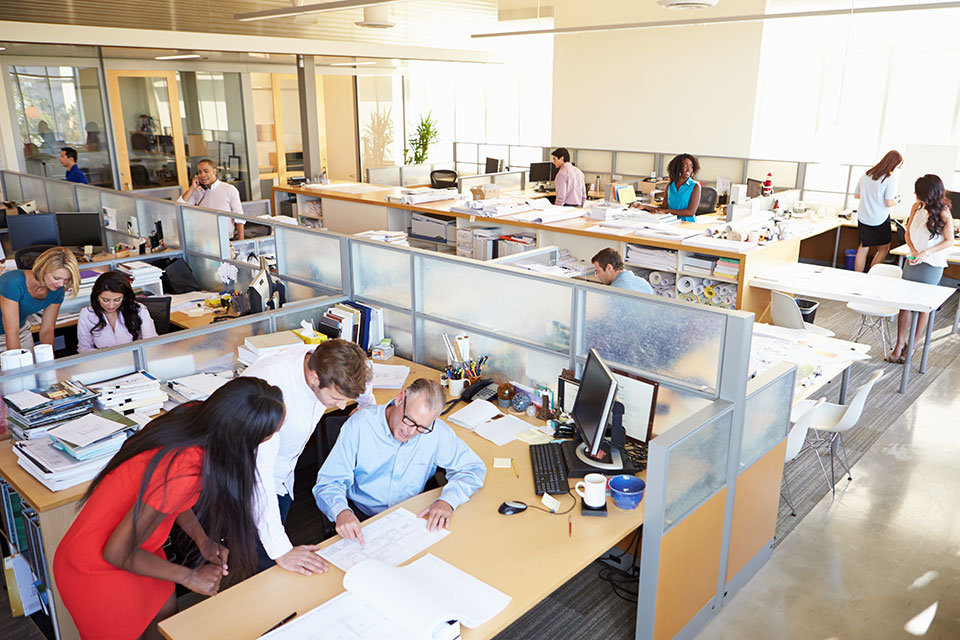The Future of the Workplace: Office Real Estate

The way we think about the workplace and manage it has changed many times since the Industrial Revolution, and certainly since humans began to work. One of the most interesting and yet least common ways to look at office workplaces - and how to manage them more effectively as part of your organisational strategy - is to think about them as real estate. Your office is a piece of real estate; you can manage it just as you would manage a piece of commercial or residential property. From trends and moving to layouts and refurbishment, there are many ways to adapt office real estate to maximise its value.
Flexible workspaces and the leap into agile
From an employer's point of view, flexible workspaces are an exciting trend that can allow you to use your office real estate much more efficiently. One study has suggested that flexible work arrangements and workspaces can generate billions of dollars in productive hours, along with considerable savings on workstation costs. It's a win-win situation because employees end up being more productive as they can choose when and where they work, while organisations save on overhead costs. Going beyond flexible workspaces is agile working, which incorporates all the features and benefits of flexible working and adds an extra dimension - employee autonomy. Going agile is about more than adopting scrum methodology in stages or sprints to create customer-centric outcomes; it's about going completely agile throughout the entire organisation. This can mean adopting fully autonomous teams that are multidisciplinary in nature and which are designed to deliver real business value across functions. Turning your workplace agile allows you to produce a customer-centric mentality, improve communication, and attract and retain the right talent. There's a lot of value in going agile, and one of the things that's going to help you ensure your office real estate is fully leveraged to support a move to agile is technology. With the right technology, you can properly support your employees in having the flexibility to work where and when they like. Studies have shown employees to embrace flexible working arrangements, in that many end up spending what would otherwise be commuting time on work instead. Desk numbers could be reduced yet still support the same number of staff. Laptops provide mobile workstations that give employees the choice to work where they like, with many feeling less stressed as a result. Mobile technology, as opposed to fixed technology, is especially important for agile and flexible working. Some firms with remote-work cultures believe the lack of geographical boundaries allow them to hire top talent regardless of where they're located in the world.Moving office: a costly proposition
Office moves can be incredibly costly, as they involve disassembling and packing fragile equipment such as desktops, moving large pieces of furniture and shifting sensitive or fragile equipment such as servers. Picking a new space can also be an involved process as you need to make sure your new premises has the right layout and infrastructure to support your equipment and work needs. Other expenses of moving office include IT labour costs associated with reassembling equipment; though if you have your own team you could do this in house. You'll be paying the removalists to transport the equipment and on top of everything else, your business will not be operating for the few days or even weeks it takes to move everything, set it up again and wait for things such as internet services and other utilities to activate. If you're moving to a larger property, you can end up paying much more on overheads along with the lease over time. While you may believe the move is absolutely necessary, you could end up realising that making better use of your current property is possible and you can in fact accommodate business expansion, at least for a little while more yet. For example, with a fit-out at your current location you might be able to more fully leverage your existing space and redesign the property to match your requirements closely. The bottom line with office moves is that they can be costly and disruptive. It's always best to exhaust all other options - and you probably do have a range of alternatives such as fitting out your current property and introducing agile and flexible working strategies - before you resort to moving. The chances are that your current premises can probably still accommodate your needs for a while longer.Improving office layouts
 Agile and flexible working arrangements can help you get the most out of your workspaces, but so can smart design. By improving office layouts, you could make the most of scarce space, boost morale, enhance productivity and strengthen reputation - especially if you receive clients in your office space. If you have an open-plan office, why not invest in some movable furniture? Having desks, workstations, walls and shelving that can be easily reconfigured enables your workspaces to be adjusted to the changing needs of employees from day to day. One day you might need to work more collaboratively; on another day your employees might need to have individual working time with plenty of quiet and privacy. We all know that sitting all day isn't great for you, so for the health of your employees, provide them with alternatives to sitting workstations. These alternatives can include stand-and-sit desks that are adjustable, yoga ball chairs, kneeling chairs and treadmill desks. Offer also small, individualised spaces where staff members can spend time alone brainstorming or working on their own projects. This is probably more important if you don't have reconfigurable furniture and your employees have access to only open plan settings. Other factors to consider when planning an office layout project include the following:
Agile and flexible working arrangements can help you get the most out of your workspaces, but so can smart design. By improving office layouts, you could make the most of scarce space, boost morale, enhance productivity and strengthen reputation - especially if you receive clients in your office space. If you have an open-plan office, why not invest in some movable furniture? Having desks, workstations, walls and shelving that can be easily reconfigured enables your workspaces to be adjusted to the changing needs of employees from day to day. One day you might need to work more collaboratively; on another day your employees might need to have individual working time with plenty of quiet and privacy. We all know that sitting all day isn't great for you, so for the health of your employees, provide them with alternatives to sitting workstations. These alternatives can include stand-and-sit desks that are adjustable, yoga ball chairs, kneeling chairs and treadmill desks. Offer also small, individualised spaces where staff members can spend time alone brainstorming or working on their own projects. This is probably more important if you don't have reconfigurable furniture and your employees have access to only open plan settings. Other factors to consider when planning an office layout project include the following:
- Lighting - Lighting is one of the most crucial design factors in boosting productivity. Too much glare can lead to headaches or even injury, whilst too little can strain the eyes.
- Heating/cooling - Studies show that the ideal temperature for productivity is around 21.6 degrees Celsius, and every degree above and below has a notable impact on productivity. Make sure your office has good airflow and is heated or cooled to the right temperature.
- Crowding - Crowding can also adversely affect performance, so try to avoid crowding and make use of light, furniture, plants, and decorative elements to increase the sense of spaciousness.
- Noise - People are affected differently by noise and noisy workplaces can distract and impede concentration and focus. Make sure your office layout offers a good mix of environments that allow staff members to work individually in quiet settings as well as collaboratively in communal areas. Provide employees with noise cancelling headsets if they're being affected by excessive noise from other teams.
- Sensory stimuli - Bring in nature to your workspaces and use colours to set a positive and productive atmosphere in the office. Use different types of materials and elements - from carpeting, paintings and artwork to curtains and plants - to create extra interest in your office interiors. This breaks up the dullness and monotony that can come with sterile environments and can have the effect of boosting your team's mood and attitude at work.
Managing employee concerns about office refurbishment
 Employees will naturally have concerns or even resistance to office refurbishments, although some of this may be kept unspoken. It's important to communicate changes and involve employees as much as possible:
Employees will naturally have concerns or even resistance to office refurbishments, although some of this may be kept unspoken. It's important to communicate changes and involve employees as much as possible:
- Involve them - Involving employees in the process from the start means they'll be kept informed and will be less likely to feel like changes are being forced upon them. If you involve them and incorporate their preferences into the process, your employees will feel more empowered and be ready to embrace the refurbished premises as their own.
- Collaboration - It's important to keep employees involved as office refurbishments involve a lot of collaboration between you and your employees. There will be days when they might have to work in another location because their workstations are being changed over or the office is being re floored.
- Ask for ideas - Actively seek suggestions from employees about what they'd like to have changed as part of the refurbishment process and incorporate as many of their suggestions as you feasibly can. This supports them in taking ownership of the new premises and can drive higher productivity and employee engagement.
- Recognise the additional demand on employees - Recognise and reward employees for the inconveniences they face during the office fitout. These demands might include extra stress due to disruption to their workspaces, or the disruption of forcing employees to work off-site. Be cognisant and understanding of the extra demands in this period.
- Communicate and sell the change - It's critical to keep everyone up to date from start to end and to really sell the refurbishment by letting them understand why it's important it takes place. Leverage your line managers and other key leaders in the organisation to keep the communication channels open and to make sure all employees know that the refurbishment is designed to make them healthier, more comfortable and productive at work.
The space in your office should be thought of as valuable real estate in the sense that if used correctly, it can become a critical driver behind business performance and success. From smart working arrangements such as agile working, to avoiding costly office moves and improving layouts to make the most of space, you can fully leverage your existing space to exceed all expectations. Targus provides high-quality office accessories and carry cases for both mobile and fixed workforces that can assist with increasing the agility of your workspace.
Contact Targus today about your organisation's specific office solution requirements.


 Australia / New Zealand
Australia / New Zealand